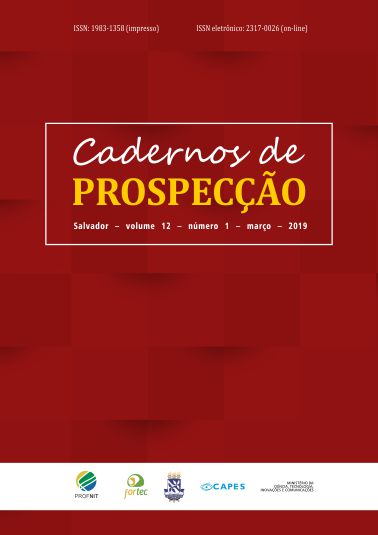Technological Prospection on Methods of Control of Aedes aegypti
DOI:
https://doi.org/10.9771/cp.v12i1.27249Keywords:
Diseases, Life Cycle, Chemical.Abstract
Aedes Aegypti has become a major public health problem in several countries, being the transmitting agent of Dengue virus, Chikungunya virus, Zika virus. Because of this problem, several chemical, mechanical and biological mosquito control methods are being developed and protected in patent form. The aim of this work was to carry out the survey of technological data to identify the methods of control of Aedes Aegypti. The research was carried out at the databases of the European Patent Office and the National Institute of Industrial Property. Brazil was the largest patent holder on the research topic. Chemical methods are the most used and studied, but the chemical components of these present risks to the environment and public health. Biological and mechanical methods are the most indicated, but they are difficult to perform.
Downloads
References
BARRETO, C. F. Aedes Aegypti - Resistência aos inseticidas químicos e as novas alternativas de controle. Revista Eletrônica Faculdade Montes Belos, [S.l.], v. 1, n. 2, p. 62-73, 2005.
BRASIL. Ministério da Saúde. Guia de Vigilância Epidemiológica. 5. ed. Brasília, DF: FUNASA, 2002.
BRASIL. Ministério da Saúde. [Base de dados – Internet]. Controle de vetores. 2014. Disponível em: <http://portalms.saude.gov.br/saude-de-a-z/controle-de-vetores-inseticidas-e-larvicidas/controle-de-vetores>. Acesso em: 21 jul. 2018.
BRASIL. Ministério da Saúde. [Base de dados – Internet]. Febre chikungunya: manejo clínico. 2015. Disponível em: <http://portalarquivos2.saude.gov.br/images/pdf/2015/fevereiro/19/febre-de-chikungunya-manejo-clinico.pdf>. Acesso em: 28 abr. 2016.
BRASIL. Ministério da Saúde. Relatório da reunião internacional para implementação de alternativas para o controle do Aedes Aegypti. Boletim Epidemiológico, [S.l.], v. 47, n. 15, p. 1-9, 2016.
FIOCRUZ – Instituto Oswaldo Cruz. [Base de dados – Internet]. Estratégias de controle do vetor. [2018]. Disponível em: <http://auladengue.ioc.fiocruz.br/?p=86>. Acesso em: 21 jul. 2018.
GOVERNO DE SANTA CATARINA. [Base de dados – Internet]. Dengue: orientações técnicas para pessoal de campo. 2015. Disponível em: <http://www.dive.sc.gov.br/conteudos/zoonoses/dengue/Manual%20Revisado%2005jan.pdf>. Acesso em: 28 abr. 2016.
MOREIRA K. M.; MAGALHÃES, C. M. Aedes Aegypti na rede: uma análise da Dengue pelos sites do Ministério da Saúde. In: II CONINTER – CONGRESSO INTERNACIONAL INTERDISCIPLINAR EM SOCIAIS E HUMANIDADES: Belo Horizonte. 2013. Anais... Belo Horizonte. 2013. Disponível em: <http://www.aninter.com.br/ANAIS%20II%20Coninter/artigos/605.pdf>. Acesso em: 28 abr. 2016.
Downloads
Published
How to Cite
Issue
Section
License
Copyright (c) 2019 Cadernos de Prospecção

This work is licensed under a Creative Commons Attribution-NonCommercial 4.0 International License.
O autor declara que: - Todos os autores foram nomeados. - Está submetendo o manuscrito com o consentimento dos outros autores. - Caso o trabalho submetido tiver sido contratado por algum empregador, tem o consentimento do referido empregador. - Os autores estão cientes de que é condição de publicação que os manuscritos submetidos a esta revista não tenham sido publicados anteriormente e não sejam submetidos ou publicados simultaneamente em outro periódico sem prévia autorização do Conselho Editorial. - Os autores concordam que o seu artigo ou parte dele possa ser distribuído e/ou reproduzido por qualquer forma, incluindo traduções, desde que sejam citados de modo completo esta revista e os autores do manuscrito. - Revista Cadernos de Prospecção está licenciado com uma Licença Creative Commons Attribution 4.0. Esta licença permite que outros remixem, adaptem e criem a partir do seu trabalho para fins não comerciais, e embora os novos trabalhos tenham de lhe atribuir o devido crédito e não possam ser usados para fins comerciais, os usuários não têm de licenciar esses trabalhos derivados sob os mesmos termos.
Este obra está licenciado com uma Licença Creative Commons Atribuição 4.0 Internacional.








